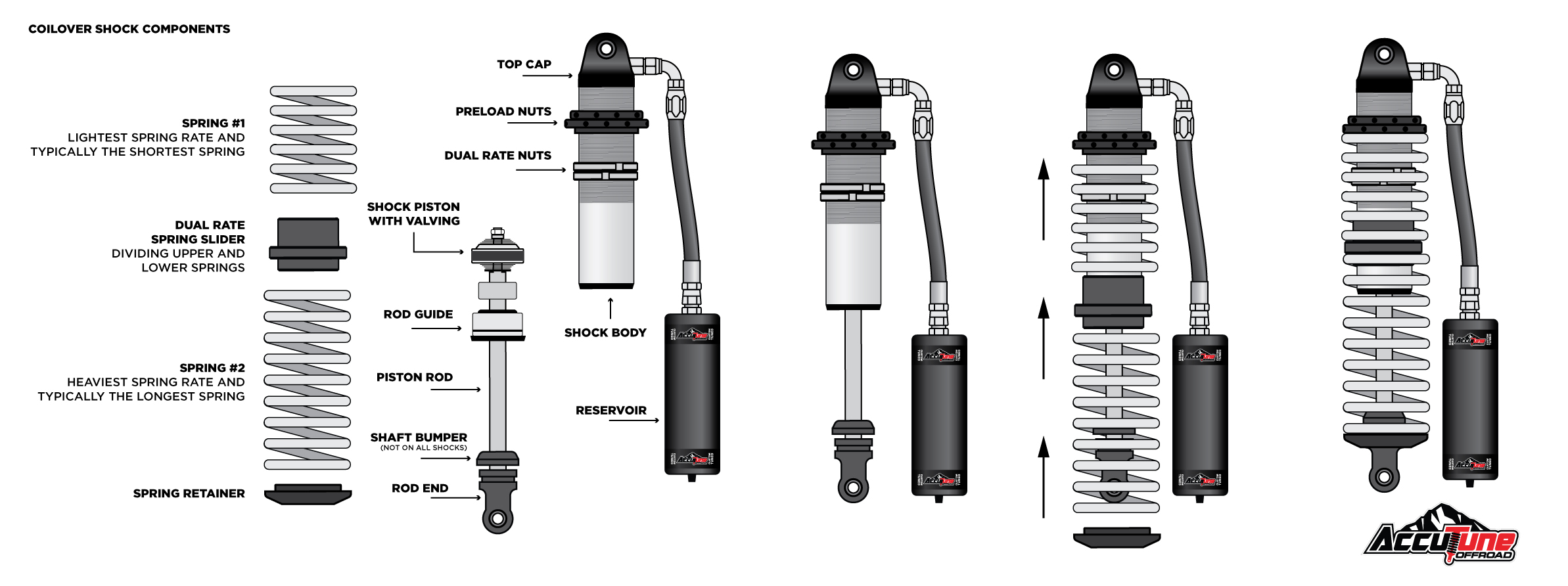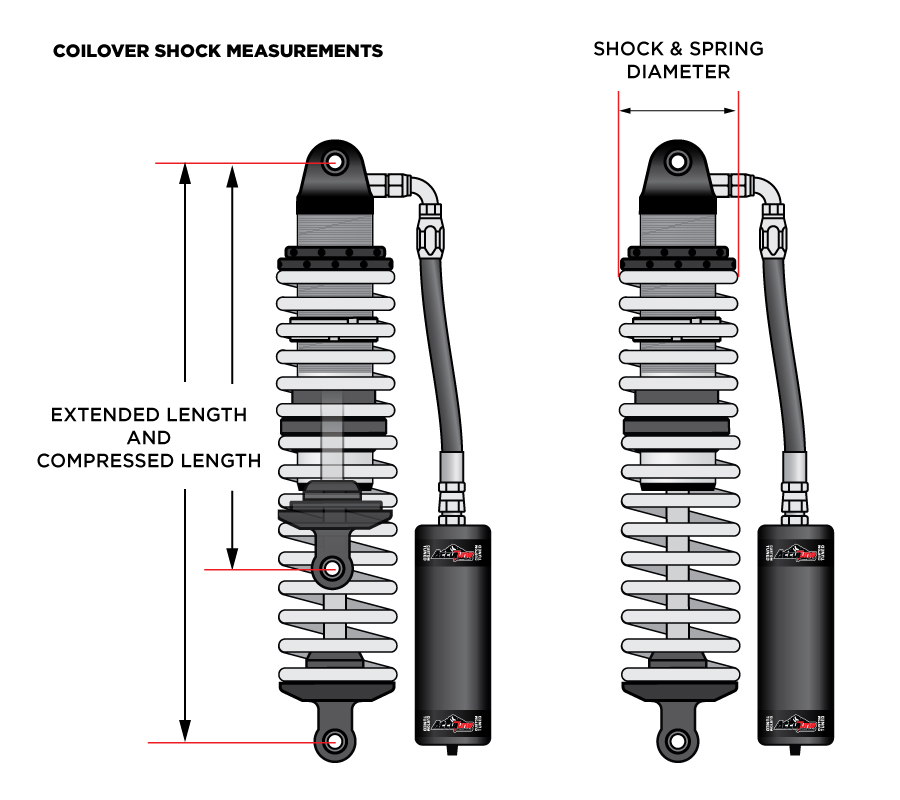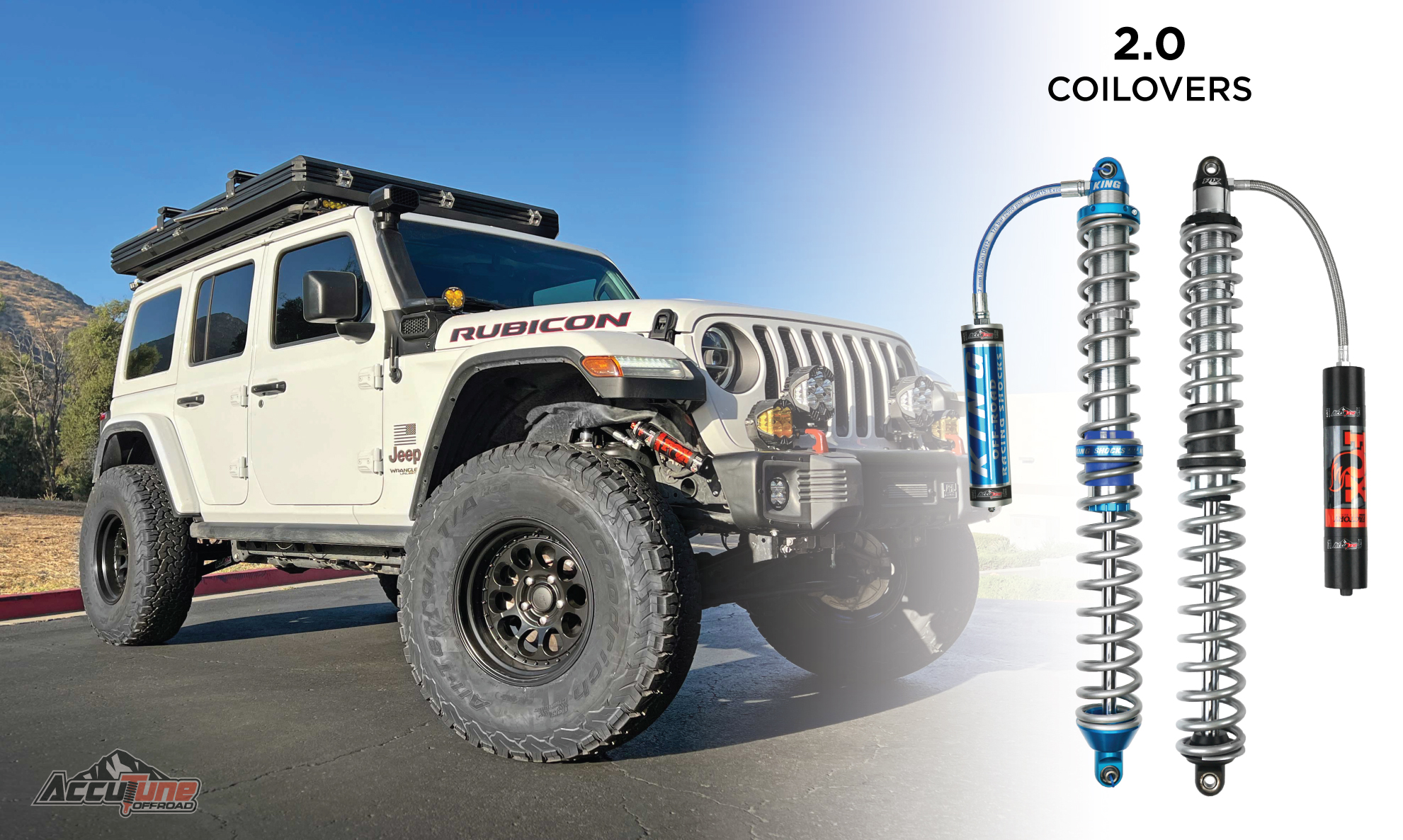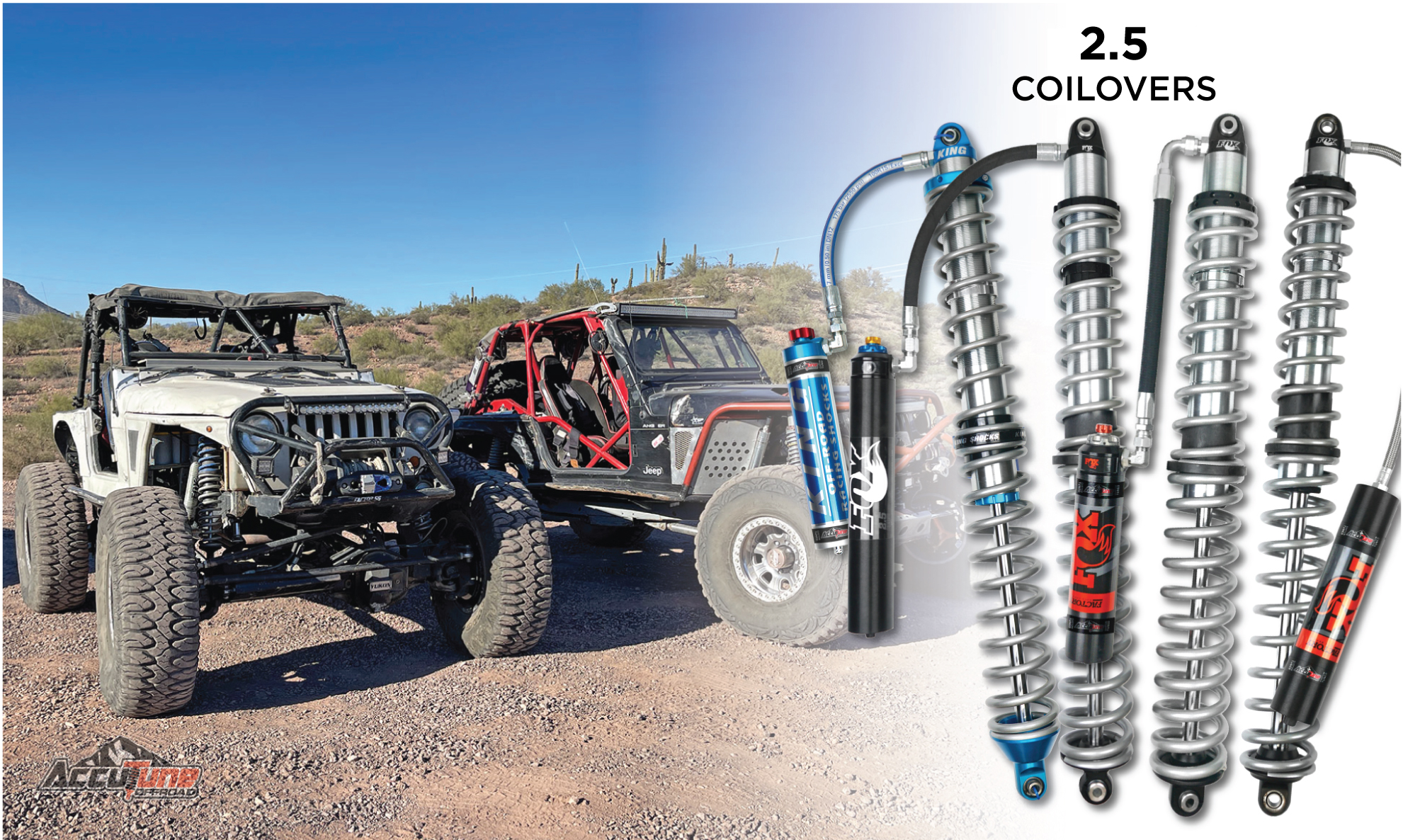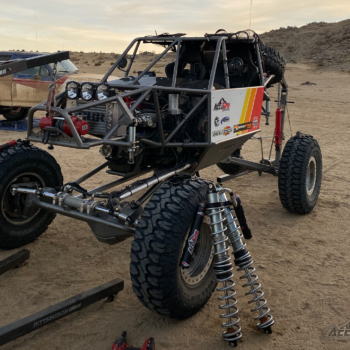March 28, 2023
So you decided to build a trail rig with coilover shocks and can’t decide on which size to get? Coilover shock options are usually narrowed down to 3 options: 2.0″, 2.5″ or sometimes even 3.0″ diameter shocks. Shock lengths are also important, but for this article we will strictly focus on shock diameter.
Topics we will cover:
-Why coilovers are a good option
-Coilover fitment on your vehicle
-Shock oil capacity & why thats important
-Ride quality & performance
-Examples of vehicle and shock combos
Things to consider before:
- How will you use the vehicle mostly? Street only, some street, trail riding, pre-running, racing?
- Can you fit the big shocks both in diameter and length?
- Do you have a brand preference? Fox or King?
- What suspension setup do you have? Shocks to axle, control arm or trailing arm?
- Are you going to use a bypass shock with the coilover?
- What level of performance are you after?
- What tune do you want, comfort or performance?
Why coilovers?
Coilover shocks are great for off-road vehicles that want the ultimate suspension performance. They can provide exceptional ride quality for daily driven vehicles, trail rigs or full blown race cars. The benefit to a coilover shock is the tunability they offer. Coilovers can be set up with a wide range of spring rates, pistons and valving. Once installed on the vehicle there are even more adjustments that need to be made to ensure everything is working properly. With a standard spring and shock set up, this is not really an option. Although coilovers can be expensive, the performance benefits are usually worth it.
- Pistons: select from high and low flow pistons (Fox only)
- Valving/Tuning: respond very well to valving changes
- Spring Rates: huge selection available for best performance
- Dual Rate Nuts: performance benefit by tuning exact location they contact at
- Preload/ride height: get exactly the correct ride height on every corner
- Travel: Capable of a lot more travel than most separate spring and shock setups
- Packaging: More compact and easier to mount one shock vs shock and spring.
Coilover Fitment
Packaging coilover shocks on a vehicle can be a daunting task, so it’s important to measure correctly to avoid any surprises on the trail. Click here to see a great article that goes over measuring for coilover shocks. Not all 14” travel shocks have the same lengths, so it will be important to see what options are available and will work for your specific build.
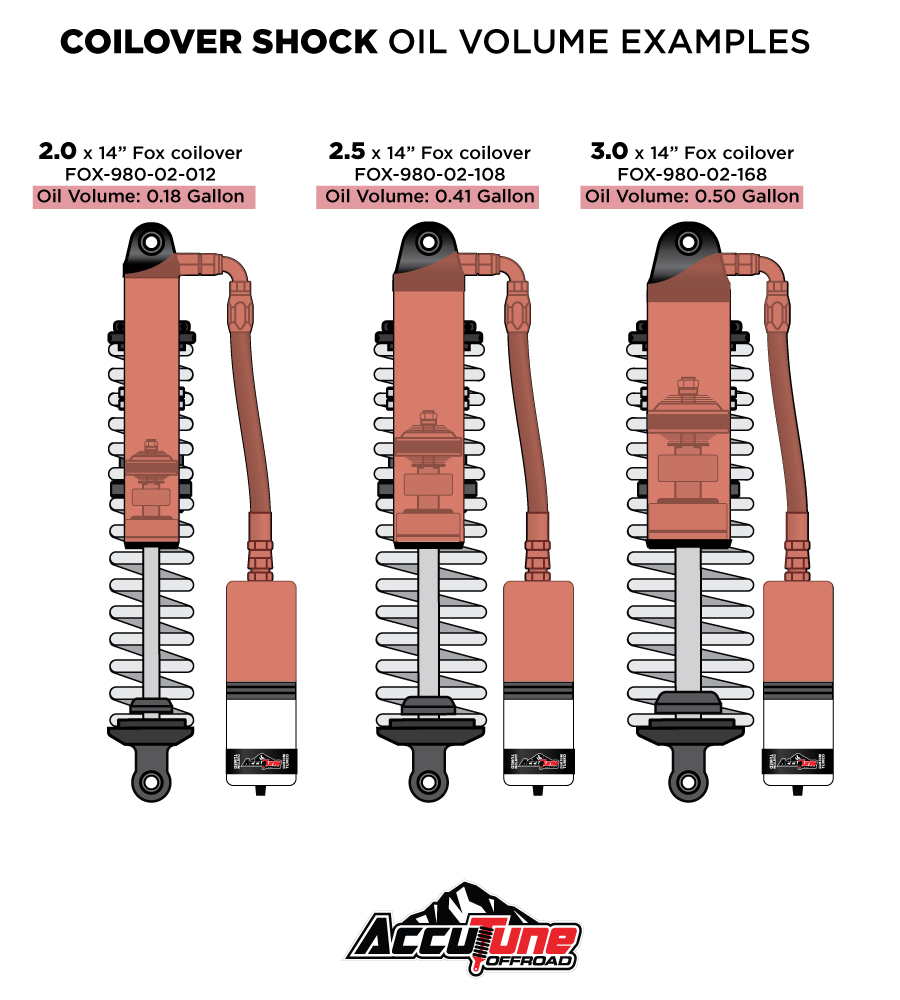 Remote Reservoirs / Oil Capacity
Remote Reservoirs / Oil Capacity
We won’t typically recommend an emulsion coilover (without a reservoir), and that has a lot to do with performance and tuning capabilities it lacks compared to a remote reservoir shock. More about that that can be found here. Shocks with remote reservoirs will hold more oil, which will help the shock to stay cooler during hard use. Keeping a shock from overheating will keep the oil and seals from wearing out too soon and also keep the shock from experiencing “shock fade”. Shock fade basically is when the shock oil gets too hot and the shock damping performance significantly decreases. So for a vehicle that sees a lot of off-road use and higher speed driving, a larger diameter shock would be a good option.
While larger shocks help with shock fade and racing environments, they do have some downsides besides fitment. Oil volume is a major part of how a shock functions. As the shock cycles, oil flows through ports in a piston and forces the valving to deflect. How much oil can flow is controlled by the port size and disk thickness. Bigger shocks have more oil to flow per amount of travel. Too much oil can actually make the vehicle ride way too stiff and uncomfortable. Even if you were to use softer valving (using thinner shims) to get the oil flowing fast enough and vehicle to ride smoother, you will risk breaking the shims. So in this case, the biggest shock available is not always the best answer. Each shock has a tuneable range, you want to select a shock that is in the tunable range for your weight and setup. Too small and they will be too soft, too big and they will be too stiff.
Ride Quality & Performance
Shocks have a stiffness range where they are happiest. In addition to having the correct spring rates, piston design and valving inside the shock is responsible for the ride quality you feel. Fox and King both have their own piston designs which will require different tuning techniques to get the best performance. This is something we take into account when recommending a specific shock, which may also lead us towards suggesting a different piston for your application. Aside from these details we help with, we are confident in our tuning abilities for any 2.0, 2.5 or 3.0 coilover shock. Note: King Shocks basically only offers one piston design per shock size
2.0 Coilover Shocks
Examples: Light weight rock crawler/buggy, daily driver Jeep/truck/SUV, slow speed vehicle with non aggressive driving.
2.0 Coilovers would be a good option for these types of vehicles. When we say slow speed driving, that is mostly referring to rock crawling off-road and not 40-50mph desert bashing for long periods of time. A 2.0 coilover can be packaged pretty easily and is an affordable option with plenty of spring rate options. Since this vehicle type is not smashing whoops, a stock bump stop or universal foam style bump stop would work fine. If you are on the fence of 2.0 vs 2.5, you should consider DSC adjusters to help with higher speed off-road driving.
2.5 Coilover Shocks
Examples: 1 ton Jeep/trail rig doing a little bit of everything, rock crawling, high speed desert.
For a more custom build with the intention of doing harder off-road trails, 2.5 coilover would be a good choice. If you really enjoy blasting around the desert you should probably consider the 2.5 coilovers to have that additional oil capacity and damping. A 2.5 coilover is very common for someone looking to do variety of off-road driving from fast desert to slow rock crawling. Any type of compression adjusters would also be a good idea to have.
3.0 Coilover Shocks
Example: Mostly high speed desert pre-running or even desert racing application. Vehicles built for extreme off-road use.
3.0 coilovers are a large shock that take a 3.75” ID coil spring, which can make packaging these very difficult to do. These large coilovers are really only needed by vehicles that are dedicated to being off-road only or in some cases are built for racing. 3.0 coilovers offer a ton of oil and damping for big impacts while driving at a high rate of speed off-road. If you are not intending for your vehicle to be racing or pre-running the desert, these shocks would be overkill and most likely offer poor ride quality. 3.0 coilovers are commonly used on trailing arms for desert race trucks combined with a bypass shock or used as an internal bypass shock for the 4800 class at King of the Hammers.



